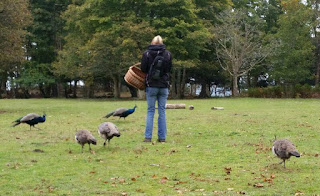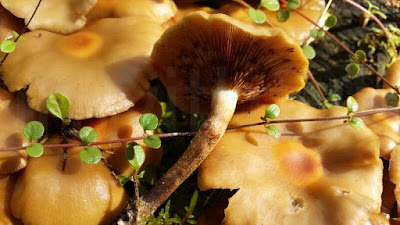 |
| Getting there Melt brown and white sugar Add laurel leaves, spices and anchovies Add red wine Finally, add mushroom extract RECIPE Done! |
Wednesday, November 4, 2015
Finally, time for brewing the mushroom elixir
The deadly Galerina
Galerina Marginata, Deadly
Usually growing on the stumps of Spruce
Usually growing on the stumps of Spruce
Not to be confused with the edible Pholiota mutabilis (below)
The P.mutabilis has thin, small hairs below the ring (ring not visible here)
The P.mutabilis grows normally on stumps of desiduous trees
Monday, November 2, 2015
Wednesday, October 21, 2015
Mushrooming in Dorset, U.K.
 |
| Approaching Brownsea Island by boat |
 |
| Identifiers at the Dorset Fungus Group at work |
 |
| An old log is the site of many good finds |
 |
| Amanita phalloides, our most deadly find |
 |
| Mushrooming among peahens, certainly a new experience |
 |
| Meadow waxcap, Hygrocybe pratensis, Engvokssopp |
 |
| Peahens and Waxcaps in a happy symbiosis |
 |
| My first Parrot Waxcap |
 |
| More Parrot Waxcaps, Hygrocybe psittacina |
 |
| A basket of edible mushrooms |
 |
| Giuseppe from The Olive Tree cooking up a tasty treat |
Wednesday, October 7, 2015
Lactarius deliciosus
 |
| Lactarius deliciosus/Furumatriske Grows in pine forests Note depressions in the stem |
 |
| Saffron milkcap/Furumatriske Edible Compared to False Saffron Milkcap (grows in spruce forests), the Saffron Milkcap is larger and firmer. The spot-like depressions in the stem of the Saffron Milkcap also differentiate it from its false cousin. |
Saturday, October 3, 2015
Wednesday, September 23, 2015
Tuesday, September 22, 2015
Monday, September 21, 2015
The Yellow Stainer
A fairy ring of poisonous Agaricus in the King's Garden, Oslo, Norway
Turns lemony yellow immediately upon bruising.
NB The yellow stain gradually disappears.
Yellow Stainer. Agaricus xanthoderma. Giftsjampinjong.
Poisonous
photos by Jon Strand
Sunday, August 30, 2015
Common stinkhorn
Despite its foul smell, the mushroom is not poisonous and immature mushrooms are consumed by some. Probably because of its reputation as an aphrodisiac.
Yellow pigments in tooth fungus
Hydnellum geogenium
The name comes the Greek hydnum meaning spongy plant or fungus.
Fruitbodies of the fungus contain a yellow pigment compound called geogenin.
Inedible
The name comes the Greek hydnum meaning spongy plant or fungus.
Fruitbodies of the fungus contain a yellow pigment compound called geogenin.
Inedible
Boletus calopus
Boletus calopus ("calo" meaning "beautiful" and "pus" meaning "foot")
Bitter Beech Bolete
Besk rørsopp
Inedible
Bitter Beech Bolete
Besk rørsopp
Inedible
Gray almond waxy cap
Distinct smell of almond essence
Edible if you like the smell
Video in French with English subtitles
Grey spotted Amanita. Recently pronounced edible by Norwegian mycologists.
Recently pronounced edible if well cooked by Norwegian mycologists.
Not recommended for amateurs who cannot differentiate between Amanitas.
What is purple and grows by spruce?
Growing in spruce forests
Supposed to smell of pencils
Not edible
Boletus appendiculatus or B. subappendiculatus?
The choice Boletus appendiculatus (Messingrørsopp) normally grows with oak.
This mushroom was found in Norway in a pine/spruce forest.
Perhaps Boletus subappendiculatus?
Edible
Edible
Just for looking . Not the cooking pot.
Spot the difference!
The Russula queletii grows near spruce, the Russula sardonia near pine.
When compared side by side, the Russula sardonia can be seen to have a darker, redder stem.
Both inedible. Sharp taste.
A mushroom that blushes
Aptly named The Blusher as the mushroom turns reddish when cut or bruised.
Edible (when well cooked)
Friday, August 21, 2015
Subscribe to:
Posts (Atom)



































